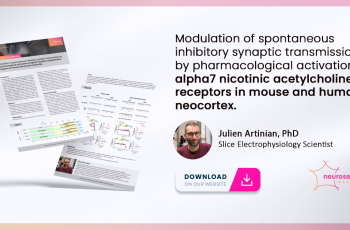
Recently, our Electrophysiology Researcher Julien Artinian explored the modulation of inhibitory synaptic transmission by activating alpha7 nicotinic acetylcholine receptors (α7nAChRs).
This study aimed to develop an assay to test compounds targeting α7nAChRs and their impact on inhibitory synaptic transmission. The results showed that selective activation of α7nAChRs increased inhibitory transmission in mouse and human cortex.
These findings have implications for learning, memory, attention, and neurotoxicity, and offer promising therapeutic possibilities.

Introduction
The alpha7-type nicotinic acetylcholine receptor (α7nAChR) is a remarkable homopentameric ligand-gated ion channel, with relatively high calcium permeability. It is widely expressed in the brain with high levels in the hippocampus and the cerebral cortex. At the cellular level, they are found in pyramidal neurons, GABAergic interneurons, but also in non-neuronal cell types such as glial and immune cells. In neurons, its activation leads to Ca2+ influx, neurotransmitter release and regulates synaptic transmission and plasticity. They appear to be critical for learning and memory and attentional functions, but also to limit inflammatory neurotoxicity. Lower levels of α7nAChRs are observed in cerebral tissue from patients with Alzheimer’s disease, schizophrenia, or Parkinson’s disease, making them interesting and promising therapeutic targets.
Objective
It was reported that pharmacological activation of α7nAChRs increases spontaneous inhibitory transmission onto pyramidal neurons in mouse medial prefrontal cortex (Udakis et al., 2016). Hence, we wanted to develop such an assay in the cerebral cortex from mice and humans to have the capability of testing new compounds targeting α7nAChRs and their ability to modulate inhibitory synaptic transmission.